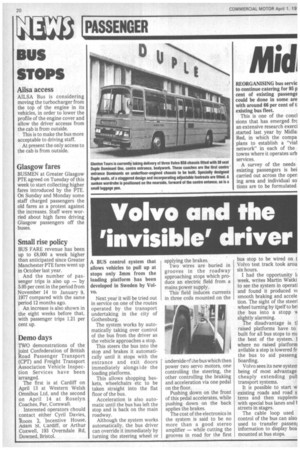Volvo and the 'invisible' driver
Page 22

If you've noticed an error in this article please click here to report it so we can fix it.
A BUS control system that allows vehicles to pull up at stops only 3mm from the loading platform has been developed in Sweden by Volvo.
Next year it will be tried out in service on one of the routes operated by the transport undertaking in the city of Gothenburg.
The system works by automatically taking over control of the bus from the driver as the vehicle approaches a stop.
This steers the bus into the stop and brakes it automatically until it stops with the entrance and exit doors immediately alongside the loading platforms.
This allows shopping baskets, wheelchairs etc to be taken straight into the flat floor of the bus.
Acceleration is also automatic until the bus has left the stop and is back on the main roadway.
Although the system works automatically, the bus driver can override it immediately by turning the steering wheel or applying the brakes.
Two wires are buried in grooves in the roadway approaching stops which produce an electric field from a mains power supply.
This field induces currents in three coils mounted on the underside of the bus which then power two servo motors, one controlling the steering, the other controlling the braking and acceleration via one pedal on the floor.
Pushing down on the front of this pedal accelerates, while pushing down on the back applies the brakes.
The cost of the electronics in the system is said to be no more than a good stereo amplifier — while cutting the grooves in road for the first bus stop to be wired on t Volvo test track took arou six hours.
I had the opportunity h week, writes Martin Watki to see the system in operati and found it produced v( smooth braking and accele tion. The sight of the steer wheel turning by itself to bri the bus into a stopp slightly alarming.
The disadvantage is tl raised platforms have to built for all bus stops to inz. the best of the system. I where no raised platform avilable a step is lowered fri the bus to aid passeng boarding.
Volvo sees.its new system being of most advantage cheaply extending pub transport systems.
It is possible to start w existing roads and road s tems and then supplern with special bus lanes and I streets in stages.
The cable loop used control of the bus can also used to transfer passen1 information to display boa mounted at bus stops.
































































































